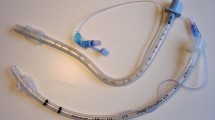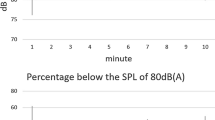Abstract
The objective of the study was to assess and perceive the vocal and pharyngeal symptoms and acoustic changes of voice after short-term endotracheal intubation and to evaluate the relation between these changes and the endotracheal tube parameters, number of intubation attempts, duration of anaesthesia, experience of anaesthesiologist. A total of 108 patients were evaluated preoperatively, 1–2 and 24 h after extubation. The vocal and pharyngeal symptoms, voice acoustic characteristics and maximum phonation time (MPT) were evaluated to find the relationship with endotracheal tube parameters, number of intubation attempts, duration of anaesthesia, experience of anaesthesiologist. All vocal and pharyngeal symptoms increased significantly at 24 h and remained significantly increased at 24 h after general anaesthesia. The vocal acoustic parameters changed significantly at 1–2 h: decrease of MPT and increase relative average perturbation were recorded. The day after the short-term intubation: only noise to harmony ratio and habitual pitch remains significantly changed. The most important endotracheal tube parameters that affect significantly (P value <0.05) the vocal function were the size of tube, cuff volume and number of intubation attempts. In relation to the anaesthesia, the changes of the acoustic parameters did not associate significantly with the anaesthesia-related parameters. No statistically significant relationship between experience of an anaesthesiologist and changes of the voice after anaesthesia was detected. Though being short-term, endotracheal anaesthesia is an invasive procedure, and its temporary influence on vocal function is important.
Similar content being viewed by others
References
Brandt L (1986) The history of endotracheal anesthesia, with special regard to the development of the endotracheal tube. Anaesthesist 35:523–530
Atkinson RS, Rushman GB, Davies NJH (eds) (1993) Lee’s synopsis of anaesthesia. ELBS with Butterworth-Heinemann, Oxford, pp 217–238
MacEwen W (1880) Clinical observations on the introduction of tracheal tubes by the mouth instead of performing tracheotomy or laryngotomy. Br Med J 2:122–124
Tadie JM, Behm E, Lecuyer L, Benhmamed R, Hans S, Brasnu D et al (2010) Post–intubation laryngeal injuries and extubation failure: a fiberoptic endoscopic study. Intensive Care Med 36:991–998
Pröschel U, Eysholdt U (1993) Short-term changes in the larynx and voice after intubation [in German]. Laryngol Rhinol Otol 72:93–97
Mencke T, Echternach M, Kleinschmidt S et al (2003) Laryngeal morbidity and quality of tracheal intubation: a randomized controlled trial. Anesthesiology 98:1049–1056
Reber A, Hauenstein L, Echternach M (2007) Laryngopharyngeal morbidity following general anaesthesia: anaesthesiological and laryngological aspects [in German]. Anaesthesist 56:177–192
Echternach M, Mencke T, Richter B, Reber A (2011) Laryngeal alteratios following endotracheal intubation and use of larynx masks [in German]. HNO 59:485–498
Rieger A (2001) Intubationsschäden: Inzidenz, komplikationen, Konsequenzen. In: Krier C, Georgi R (eds) Airway–Management–Die Sicherung der Atemwege. Thieme, Stuttgart New York, pp 139–153
Peppard S, Dickens J (1983) Laryngeal injury following short term intubation. Ann Otol Rhinol Laryngol 92:327–330
Alessi D, Hanson D, Berci G (1989) Bedside videolaryngoscopic assessment of intubation trauma. Ann Otol Rhinol Laryngol 98:586–590
Hamdan AL, Sibai A, Rameh C et al (2007) Short-term effects of endotracheal intubation on voice. J Voice 21:762–768
Bishop M (1989) Mechanisms of laryngotracheal injury following prolonged tracheal intubation. Chest 96:185–186
Wittekamp BHJ, van Mook WNKA, Tjan DHT, Zwaveling JH, Bergmans DCJJ (2009) Clinical review: post–extubation laryngeal edema and extubation failure in critically ill adult patients. Crit Care 13:233
Leonard R, Senders C, Charpied G (1992) Effects of long term intubation on vocal fold mucosa in dogs. J Voice 6:86–93
Hilding AC (1971) Laryngotracheal damage during intra-taracheal anesthesia: demonstration by staing the unfixed specimen with methylene blue. Ann Otol 80:565–580
Beckford NS, Mayo R, Wilkinson A III, Tierney M (1990) Effects of short endotracheal intubation on vocal function. Laryngoscope 100:331–336
Hixon TJ (1987) Respiratory function in speech and song. Little brown, Boston, p 27
Cartwright P, Prys-Roberts C, Gill K, Dye A, Stafford M, Gray A (1983) Ventilatory depression related to plasma fentanyl concentrations during and after anesthesia in humans. Anesth Analg 62:966–974
Horii Y, Fuller B (1990) Selected acoustic characteristics of voices before intubation and after extubation. J Speech Lang Hear Res 33:505–510
Gleeson MJ, Fourcin AJ (1983) Clinical analysis of laryngeal trauma secondary to intubation. J R Soc Med 76:928
Lesser THJ, Williams RG, Hoddinott C (1986) Laryngographic changes following endotracheal intubation in adults. Br J Disord Commun 21:239–244
Yonick T, Reich A, Minifie F, Fink B (1990) Acoustical effects of endotracheal intubation. Speech Hear Disord 55:427–433
Garrett KL, Healy EC (1987) An acoustic analysis of fluctuations in the voices of normal adult speakers across three times of day. J Acoust Soc Am 82:58–62
Artkoski M, Tommila J, Laukkanen AM (2002) Changes in voice during a day in normal voices without vocal loading. Log Phon Vocol 27:118–123
Conflict of interest
None.
Author information
Authors and Affiliations
Corresponding author
Rights and permissions
About this article
Cite this article
Paulauskiene, I., Lesinskas, E. & Petrulionis, M. The temporary effect of short-term endotracheal intubation on vocal function. Eur Arch Otorhinolaryngol 270, 205–210 (2013). https://doi.org/10.1007/s00405-012-2130-4
Received:
Accepted:
Published:
Issue Date:
DOI: https://doi.org/10.1007/s00405-012-2130-4




